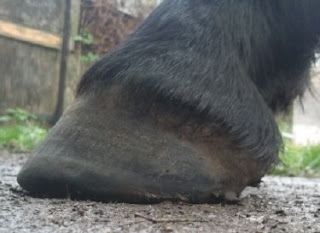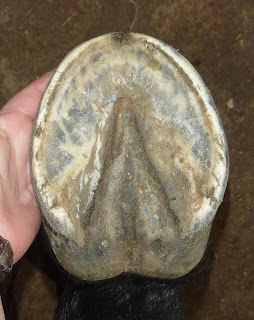Both in the short term because of badly fitted shoes and in the long term because of damage to structure.
We have looked at the cadaver photo before. It shows a nail which has been placed under veterinary supervision into a hoof. You can see how it is slipped between the inner (water line) and outer walls.
Often when hoof is not healthy and is not maintaining the healing angle to the ground, the toe starts to become more sloping and creeps forward. Farriers are taught that hooves need to be maintained within certain angles. And they do this using largely by thinning the hoof wall and jacking up the heels.
Again looking at the cadaver hoof, you can see how if the outer wall is thinned, this precludes the 'ideal' nail placement. So where does the nail then go? We can see this from the second photo.
 |
| Nail placement |
In the second photo the hoof wall has been thinned and the farrier has been left with no wall to nail into. As a consequence the nails have gone through the white line (ouch) or worse through the body of the foot (double ouch). Look again at the cadaver nail - you can see for yourself what this means.
Note also on the second photo how the white line is stretched and there is evidence of blood.
This has happened in at least half of the horses I deshoe.
Has it happened to a horse near you?
A quick anecdote. Had my last horse from 19 months of age. At two the farrier said I should take her back because she had terrible feet. We had a lengthy conversation and one of the things that I remember was the farrier telling me that 'All horses feet creep forwards and the only way to deal with them is to rasp the toes back.' and that 'All wild horses are dead by about 5 because there is no one to take care of their feet.'. He also told me that 'We had bred the feet off horses.' and that 'Modern horses feet were too small.'.
I am happy to report the horse didn't have terrible feet, at least not genetically. Upto that point we had been making a complete hash of looking after them. But we got better and in later years she was happy to cover all sorts of terrain for many miles completely barefoot.
But boy did I have a lot to learn to get them that way. (mostly cut the sugar and expensive bagged rubbish and let her move naturally and a lot)

























































